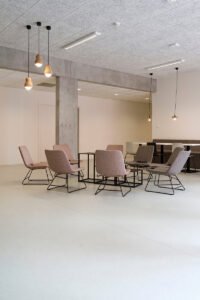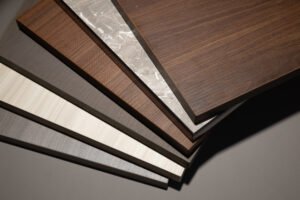Are you struggling to choose between PVC and ABS edge banding for your furniture projects? You’re not alone — many furniture makers face the same decision.
PVC and ABS are two common types of edge banding materials used on wood panels. Both have advantages, but they differ in flexibility, durability, environmental impact, and cost.

If you’re building or sourcing furniture, the edge banding you choose affects not only the look but also the performance and value of your product. Let’s go step-by-step to find out which material suits your needs better.
What Are PVC and ABS Edge Banding Materials?
Many manufacturers feel stuck when choosing materials without knowing what they’re really made of. The names may sound technical, but the truth is simpler than it seems.
PVC and ABS edge banding are plastic-based materials used to cover the exposed edges of wood panels. They help improve appearance, prevent damage, and protect from moisture.

Understanding the Basics
Here’s how I usually explain it to new clients:
| Feature | PVC (Polyvinyl Chloride) | ABS (Acrylonitrile Butadiene Styrene) |
|---|---|---|
| Material Base | Chlorine-based plastic | Petroleum-based thermoplastic |
| Texture | Flexible, smooth | Slightly stiffer, matte or glossy |
| Environmental Impact | Less eco-friendly | More eco-friendly, recyclable |
| Resistance | Good water resistance | High impact resistance |
| Usage | General furniture | Eco-conscious or high-performance needs |
PVC is more common. It’s easy to produce and works for many furniture types. ABS, on the other hand, is rising in popularity for customers who care about the environment or need higher strength. From my own experience in export markets like Europe, ABS is becoming the preferred material for buyers asking for RoHS or REACH compliance.
Key Differences Between PVC and ABS Edge Banding?
It’s hard to choose when both materials seem similar at first glance. But the small details make a big difference in real-world use.
PVC edge banding is more flexible and affordable, while ABS is more durable and environmentally friendly.

Performance, Environment, and Flexibility Compared
Let’s break down how they compare in practical ways:
1. Durability
- PVC handles basic wear and tear. Good enough for daily use in home or office furniture.
- ABS is tougher. It holds up better under pressure or frequent impact — useful in commercial settings or kids’ furniture.
2. Workability
- PVC is easier to curve, trim, and apply, especially on complex shapes.
- ABS may need more precise machinery but gives a cleaner finish.
3. Heat Resistance
- PVC can warp if exposed to high heat for long.
- ABS is more stable in heat, which is useful in kitchens or near machinery.
4. Eco-friendliness
- PVC contains chlorine. Disposal is a concern.
- ABS is 100% recyclable. No harmful gases during production.
In short, PVC is easier to work with. ABS is better for strength and sustainability. For me, when we get requests from clients in Germany or Scandinavia, ABS is always on their approved material list.
Which Edge Banding Is Better for Your Wood Panel Projects?
If you don’t match material to project, you may face returns or damage complaints later. It’s not about which material is “better” — it’s about what’s better for your needs.
PVC is ideal for simple projects or budget furniture. ABS fits better for high-end, eco-conscious, or heavy-use applications.

Choosing Based on Your Use Case
Here are some typical use cases that I often recommend to clients:
| Project Type | Recommended Material | Why |
|---|---|---|
| Basic office furniture | PVC | Lower cost, easy application |
| Kitchen cabinets | ABS | Better heat and moisture resistance |
| DIY furniture kits | PVC | Easy to apply, cost-efficient |
| Premium furniture | ABS | Stronger, eco-compliant |
| School or hospital furniture | ABS | Impact-resistant, safer material |
When I worked on a project for a Nordic furniture brand, their request was clear: “Only ABS, with full REACH compliance.” That’s when I saw how much influence material choice can have on brand positioning.
Cost Comparison: PVC vs ABS Edge Banding
One of the first questions I get from new buyers is, “How much more does ABS cost?” The price gap is real, but not always huge.
PVC is cheaper per meter and more widely available. ABS has a higher upfront cost, but may offer long-term savings through durability and fewer replacements.

Breaking Down the Real Cost
| Factor | PVC | ABS |
|---|---|---|
| Raw Material Cost | Lower | Higher |
| Processing Cost | Lower | Slightly higher |
| Shipping Efficiency | Higher (flexible rolls) | Slightly lower (stiffer material) |
| Waste Rate | Low | Very low (stronger, less breakage) |
| Lifespan | 3–5 years | 5–10 years |
| Long-term Cost | More frequent replacement | Less frequent maintenance |
So, while the upfront price per meter may favor PVC, ABS might cost less in high-usage scenarios. I had a client in Canada switch to ABS, and a year later, they told me, “We haven’t had to replace a single edge strip since then.”
Conclusion
Both PVC and ABS have their place in wood panel furniture. The right choice depends on your budget, values, and product goals.





